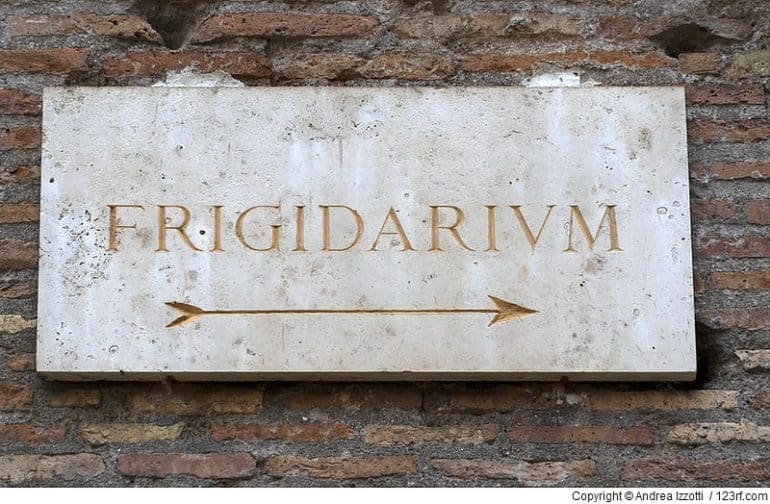Wellness as a Roman invention
We owe so many modern things and facilities to the creative and industrious Romans. Without them, we would have no alphabet, no legal system that draws in no small part on Roman law, but even such mundane things as water guidance systems and roof tiles are indebted to Roman culture. The Romans were true masters at combining the useful with the pleasant. Even regular visits to the spa, the public bathing and wellness facility, served to cultivate contacts, initiate business of all kinds and an early form of networking.
“Sana per Aquam” Health through Water
The modern abbreviation SPA originates from this bathing culture. It stands for “sanus per aquam” – health through water. In order to secure this advantage without restriction, wealthy Romans also relied on their own small-scale baths in their private residences and villas. This was also where guests were received and entertained, relationships were cultivated and important decisions were made.
Women had their own baths, which – as Roman mosaics from Piazza Armerina in Sicily, for example, show us – they never frequented naked, but in an early variant of the bikini. The bathing ritual itself followed a fixed procedure, from which one hoped for the greatest possible benefit for one’s own health. Parallels to our present-day visits to saunas, spas, and the like are no coincidence, but part of a cultural heritage that goes back a long way.
Frigidarium, caldarium, tepidarium and sudatorium
Each of these terms describes a section of the Roman bathing protocol. The sequence of a visit to the baths can be roughly imagined as follows: The entrance area was used for depositing and stowing clothes in specially designed niches, the forerunners of today’s lockers. The personal belongings were guarded by slaves, who either followed their masters into the baths or had to perform their duties there.
Frigidarium: The cold bathing room of the Romans
Next stop was the frigidarium, the cold bath, where one’s purification ritual began with a spirited plunge into the cold water pool. Based on the floor plans of Roman baths known to us today, thanks to archaeological excavations, researchers assume that the frigidarium, as the largest room, was also the main place of stay in the wellness temple.
In the famous Caracalla Baths, for example, the frigidarium had room for 1600 people. In addition to cold water showers, cleansing with “strigilis”, the forerunners of modern bath brushes, massages, and oiling of the body with essential oils also took place here.

Tepidarium: warming room with benches and couches
In the next station, the Tepidarium, one warmed up with mild heat, which was brought into the room by an ingenious heating system, the forerunner of today’s underfloor heating. Then one entered the caldarium, the hot bathroom. Archaeological findings prove the orientation of these rooms to the south. Large window fronts offered variety, while one revived one’s circulation in the hot water pools. The floor temperature could reach over 50 °C (122 °F), bathing shoes made of wood were therefore in use.
The caldarium is therefore often considered the precursor of our sauna due to the combination of hot air, hot water and steam. However, researchers are divided on this point. Steam baths were also known in the Arab world, long before the Romans. And in Europe, the Normans, Vikings and sedentary inhabitants of the Scandinavian countries also cultivated a culture of sweating in tents and specially built huts.
Sudatorium: The steam sweat bath in ancient thermal baths
The Roman Sudatorium brings us even closer to the modern sauna. This last station of the purification ritual was a room strongly heated by means of a charcoal stove without any water sources. The dry heat formed the conclusion of the bathing process, but did not necessarily already have to be the final station of the thermal bath visit. Even then, resourceful merchants offered their wares, snacks, and refreshments at market stalls in the baths.
Indoor and outdoor relaxation rooms could be used for relaxation, reading rooms for spiritual edification. In the classical spas, doctors had their own rooms for serving patients on site. Not to be forgotten, as a special place of delight for archaeologists: the latrines, which centuries later still offer revealing finds with historical waste such as pottery shards and other relics of civilization garbage.
Frigidarium: The Place to Be
However, all these areas mentioned at the end were only side shows. The main hub for information, business initiations, marriages, and intrigues was the Frigidarium. What, centuries later, are online job or singles exchanges, social networks and business lunches, began among the Romans with a cold bath. Their knowledge of the health benefits of cold water has survived through the ages, and thanks to Sebastian Kneipp and his modern fan base, has been preserved in our wellness culture today.

